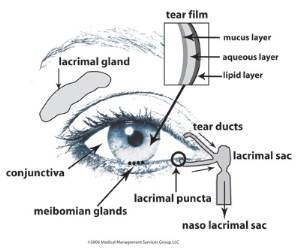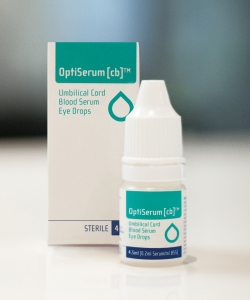You are here
Umbilical Cord Blood Serum Eye Drops

The ocular (eye) surface includes two major territories: the cornea and the conjunctiva, bordered by the upper and lower eyelids. It is imperative that this ocular surface remains healthy to ensure clear vision, maintain comfort and guard against infections.
Role of tears in healthy eyes
The ability to form tears plays an essential role in the maintenance of a healthy cornea and conjunctiva. The tear film over the eye's surface consists of mucus, aqueous, and lipid layers and contains many growth factors and vitamin A, which are essential for regulating the proliferation, differentiation, and maturation of the ocular surface epithelium.
Ocular surface disorders, including dry eye disease, are characterized by a decrease in quality and quantity of the tear film and changes in cell characteristics of the conjunctival epithelium. These disorders can severely affect eyesight and quality of life. Patients with ocular surface diseases suffer from loss of vision, discomfort and pain, infection, erosion, ulceration, and destruction with scarring of the eye surface.
Conventional treatments for ocular surface disorders include the application of artificial tears, topical anti-inflammatory agents, therapeutic contact lenses, and surgery to block the lacrimal puncta so that tears do not drain away.
Similarity between blood and tears
It is known that human blood serum contains many growth factors and other components that are similar to tears. Patients suffering from ocular surface diseases have often relied on serum made from their own blood to treat dry eye symptoms and to help heal erosions of the eye surface.
 Subsequently, it was discovered that umbilical cord blood serum contained similar growth factors and Vitamin A. Cord blood has 2-3 times higher concentrations of these factors than adult blood serum and tears themselves.
Subsequently, it was discovered that umbilical cord blood serum contained similar growth factors and Vitamin A. Cord blood has 2-3 times higher concentrations of these factors than adult blood serum and tears themselves.
Umbilical cord blood serum is effective in stimulating and regulating the proliferation, differentiation, and maturation of the ocular surface epithelium. In addition cord blood serum has been shown to have anti-inflammatory effects. Finally, cord blood serum has bacteriostatic effects due to antibacterial agents such as IgG, lysozymes and complement.
The efficacy of Umbilical Cord Blood Serum has been demonstrated in the following conditions:
- Severe Dry eye with or without primary Sjögren's syndrome
- Ocular Graft-Versus-Host-Disease (GVHD)
- Persistent Epithelial Defects
- Corneal and conjunctival ulcers from any cause
- Recurrent corneal erosions
- Chemical burns
- Neurotrophic keratitis
- Refractory surgery
- Post Corneal Transplant
Therefore, it is recommended that umbilical cord blood serum drops can be used in any condition that may cause delayed epithelial healing of the eye or dysfunctional tear film. The drops have been successfully used in both adults and children.
Source of cord blood serum
Umbilical Cord Blood Serum eye drops are prepared from the umbilical cord blood donated by consenting mothers during the birthing process. All donors sign an informed consent and are screened for the following transmissible diseases: HIV, Hepatitis B & C, HTLV, Syphilis and CMV. The serum is discarded if any of these are positive.
The umbilical cord blood is collected from the umbilical vein of the placenta after delivery of the baby. The blood is left to clot at room temperature and centrifuged to separate the serum fraction from the cellular fraction. All samples are tested for bacterial and fungal contamination to ensure sterility of the product. The serum fraction is diluted to a 20% dilution and decanted into 5 ml eye dropper bottles using aseptic techniques in a clean room environment. The bottled serum is then frozen at -80°C for long term storage.
A cord blood collection volume can range from 60ml-120ml. The serum fraction is usually about 40% of the volume. After testing and 20% dilution, about 20-40 bottles of serum can be produced from a single cord blood collection.
As there are no preservatives in the eye drops, they must be stored frozen. The eye drops can be stored at a temperature less than -25°C for up to 2 years and at -18°C for 1 year. On prescription by a doctor, the eye drops are dispensed to a patient frozen, shipped from the laboratory on dry ice. At home, the patient must store the drops in their home freezer. To use the drops, the bottle of frozen drops must be thawed at room temperature and thereafter stored in the refrigerator at 2-8°C for a maximum of 7-10 days.

Regimen of patient therapy
Ophthalmologists suggest that patients use the cord blood serum eye drops in the affected eye or eyes in doses of 1-2 drops, up to 4-5 times per day, for up to 4-6 weeks. The drops can be used daily on a long term basis in patients who consistently have severe dry eyes. Treatment can be alternated between artificial tears and cord blood serum as the doctor sees fit.
Topical administration of umbilical cord blood serum does not cause adverse effects on the eye, because the serum has reduced immunogenicity. The titres of IgM and IgG antibodies are low and anti-A and anti-B antibodies are absent or only weakly detectable in the serum. The eye is also an immune privileged site with low immunogenicity on the surface. Umbilical cord blood serum does not contain any preservatives and does not cause any toxic or allergic reactions in the eye.
Umbilical cord blood serum has been shown to have great healing properties in ocular surface disorders. It is easy to collect and is immediately available to the patient in convenient bottles. It is also very useful in patients who have poor general health and who are unable to give blood to obtain their own serum.
References
- Yoon, K.C; Use of Umbilical cord serum in ophthalmology; Chonnam Med J. 2014; 50:82-85
- Vajpayee, R.B. et al., Evaluation of umbilical cord serum therapy for persistent corneal epithelial defects. British journal of ophthalmology, 2003; 87(11):1312-1316.
